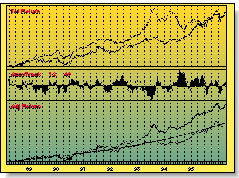
MONEY MANAGEMENT
Dynamic Asset Allocation Beyond Buy And Hold
by Gary J. Harloff, Ph.D.
Even during the strongest of bull markets, not every investment rises at the same rate. This range of performance among different investments has led to money managers developing strategies to dynamically allocate among a choice of investments. Here, a money manager explains his recent research into this subject.
Individuals, professionals and institutions diversify their investments over several asset classes to seek a specific return versus risk objective. An example of a typical allocation might be 65% equities, 30% bonds and 5% money markets. Such allocations might be adjusted for investor risk tolerance and/or economic conditions, such as long-term interest rate, inflation, manufacturing capacity utilization, employment level and business cycle position. Usually, many factors are analyzed in combination to determine an asset allocation.
There are at least three approaches to asset allocation: strategic, tactical and dynamic. In strategic allocation, the investor allots a fixed percentage to several asset classes for a long period. Periodically, the portfolio is adjusted to bring it back to the original allocation weights, by selling winners and buying losers. When the return from one asset class rises, another typically declines, which reduces overall return.
The next approach is tactical asset allocation. Here, the investor changes asset weights by large increments between a few asset classes, based on market return predictions. This can be accomplished by either shifting resources from one business sector to another, depending on business cycle knowledge (this is known as sector rotation), or by utilizing classical market timing, which invests in stocks in up markets and cash equivalents in down markets. Classical market timers generally use technical and/or economic indicators to move between a specific asset class and a cash equivalent.
Dynamic asset allocation is the third approach, and it is the one in which the investor shifts capital among several asset classes, depending on market conditions.
IN PREVIOUS STUDIES
The five best mutual fund newsletter portfolios tracked by The Hulbert Financial Digest (as of 1995) have an average yearly return of 8.5% over the eight-year period ended August 31, 1995. This compares to a Wilshire 5000 total return (price appreciation and dividends) of 10.3% annually. In 1996, Hulbert reported that only five of the 30 bond-timing newsletters beat the average buy-and-hold Shearson Lehman Hutton All-Maturities Treasury Index of 7.5% per year over the five-year period ended August 31, 1996. The highest-performing newsletter obtained a return of 9.1%. Digest publisher Mark Hulbert observed that about 90% of the variance in the long-term newsletter portfolio performance is due to asset allocation, whereas market timing and selection make up about 10% of the performance.A study in 1991 found that 91.5% of the pension fund differential return could be explained by the strategic asset allocation policy. Thus, of primary importance to investor return is correct asset allocation, and individual stock or fund selection is of secondary importance. And it is best to be in asset classes that appreciate at high rates.

FIGURE 1: ACCUTRACK INDICATOR. HereÕs an example of switching with AccuTrack between aggressive growth and emerging market asset classes. The top is the aggressive growth and emerging market asset classes. The middle is the AccuTrack indicator, and the bottom graph illustrates the equity curves.
Digest publisher Mark Hulbert observed that about 90% of the variance in the long-term newsletter portfolio performance is due to asset allocation, whereas market timing and selection make up about 10% of the performance.
Gary J. Harloff , who publishes a mutual fund newsletter called The Intelligent Fund Investor, is a principal of Harloff Inc., an SEC-registered investment advisory firm located at 26106 Tallwood Drive, North Olmsted, OH 44070, 440 734-7275. He may also be reached via E-mail at gjharloff@prodigy.net. Harloff is a member of the Society of Asset Allocators and Fund Timers Inc. and wishes to acknowledge the encouragement of R. Buck Gray and Paul Terrano and the assistance of Linda Ferentchak, Peter Mauthe, John Sosnowy and Jerry Wagner.Excerpted from an article originally published in the January 1998 issue of Technical Analysis of STOCKS & COMMODITIES magazine. All rights reserved. © Copyright 1997, Technical Analysis, Inc.